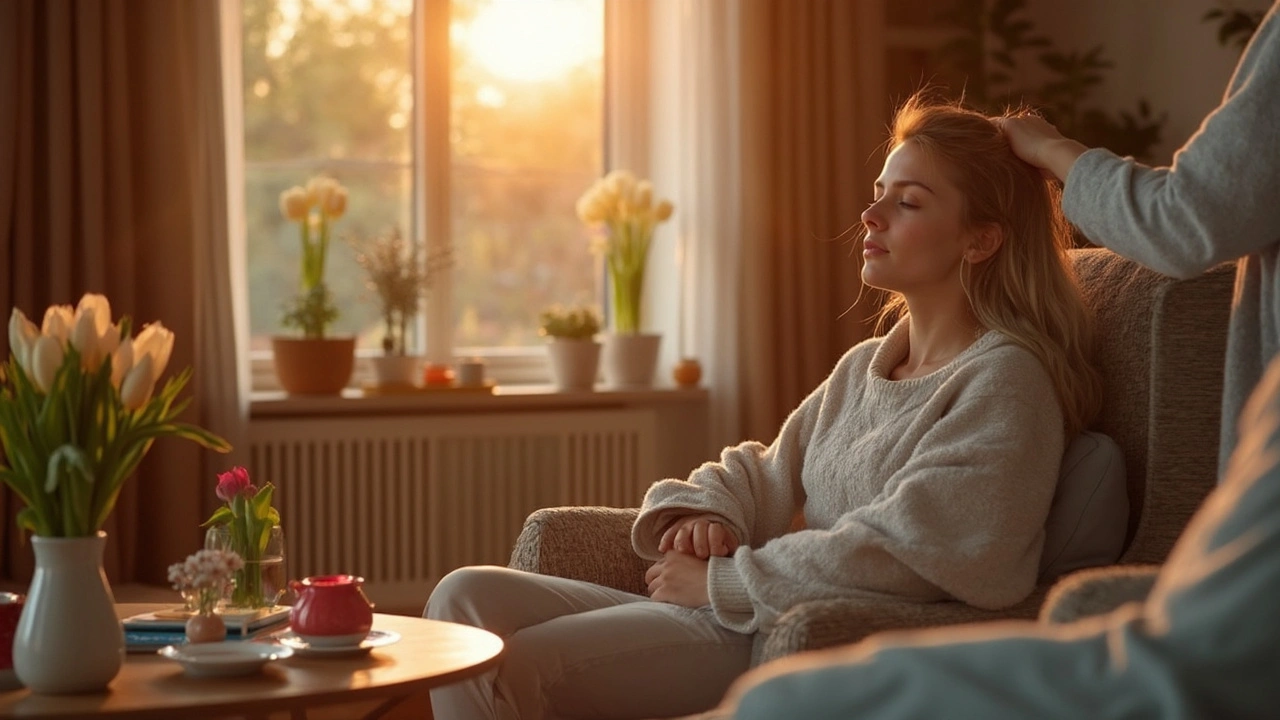DIY Head Massage Techniques: The Ultimate Guide for Relief and Relaxation

Ever catch yourself rubbing your temples after a long day? There’s a reason for that—it’s basic instinct, and honestly, head massage feels amazing. The best part? You don’t need to be a massage therapist to get real results. With just your hands (and maybe some oil if you’re feeling fancy), you can ease tension, clear your head, and melt away stress in a few minutes.
All you really need is a quiet spot and about five minutes. A head massage boosts blood flow, loosens those tight muscles that come from staring at screens, and can even help you sleep better. No special tools are required, but if you have a scalp brush or a little bit of coconut oil, you can take things up a notch. Think of this as a mini spa moment, right at your kitchen table—or wherever you can grab a break.
- Key Points
- Direct Answer
- Why DIY Head Massage Matters
- Simple Head Massage Techniques to Try at Home
- Tips, Benefits, and Common Mistakes
- Safety and When to Avoid DIY Head Massages
Key Points
If you’re looking for an instant, affordable boost to your well-being, doing your own head massage is a no-brainer. Here’s what you really need to know before getting started:
- Anyone can learn basic DIY head massage techniques at home with just their hands—no expensive equipment needed.
- A quick scalp massage increases local blood flow by up to 70% for several minutes, which can help with tension headaches and relaxation.
- Studies show head massages can lower the stress hormone cortisol by about 31% after just a 15-minute session.
- Frequent head massages, even once or twice a week, may help reduce migraine frequency, boost mental clarity, and support better sleep.
- Safe for all ages—just avoid if you have open wounds, scalp infections, or are recovering from recent head injuries.
| Benefit | Stat/Fact |
|---|---|
| Improved blood flow | Up to 70% increase during massage |
| Stress relief | 31% drop in cortisol after 15 min |
| Better sleep | Regular massage can help people fall asleep faster |
| Headache relief | Many report less pain after a five-minute massage |
It only takes a few minutes a day to notice the difference. Whether you’re dealing with tension, headaches, or just a bad mood, these techniques are quick, easy, and can be done any time you need a reset.
Direct Answer
If you want fast stress relief or headaches to back off, learning DIY head massage techniques is a game changer. Anyone can do it at home—no special gear or training needed. Studies show that just five minutes of self-massage on your scalp can lower muscle tension, help you focus, and even make you feel happier by sparking the “feel good” chemicals in your brain.
The basic idea is simple: use your fingertips and palms in gentle, circular motions across your scalp, temples, and the back of your head. Massage each area for at least 30 seconds before moving on. Starting at the hairline and working your way back—or vice versa—can cover all the main pressure points. It’s not fancy, but it works.
- Find a comfy seat and let your shoulders relax.
- Use your fingertips—not your nails—to gently press in circles over your whole scalp.
- Focus on tight spots like your temples, behind your ears, and the base of your skull.
- If you want, grab a tablespoon of coconut or olive oil. It makes the massage smoother—just be ready for a hair wash after.
- Take deep breaths while you’re at it; it helps your body wind down even more.
Want to know what’s happening under the surface? A small 2023 study found that a daily 5-minute scalp massage helped reduce both blood pressure and heart rate on measurable levels. That’s not just in your head—your whole body feels it.
| DIY Head Massage Benefits | Time Needed |
|---|---|
| Reduces tension headaches | 3-5 minutes |
| Improves blood flow to scalp | 5 minutes |
| Boosts relaxation hormones | 5-10 minutes |
| Can make hair feel healthier | 5 minutes, daily |
One last tip: head massages are safe for most people, but if you have any skin conditions or scalp injuries, skip it or talk to a doctor first.
Why DIY Head Massage Matters
Why bother learning head massage if you can just wait until your next salon visit? Turns out, giving yourself a head massage at home isn’t just about short-term pleasure—it’s got some solid science and real-life perks behind it.
Let’s talk facts. Did you know that a 2016 study found that participants who performed self-scalp massage for 4 minutes daily, five times a week, reported much lower tension and better sleep after just three weeks? That’s something you can fit into even the busiest schedule.
Here's what makes DIY head massage such a game changer:
- Stress Buster: Gentle pressure on your scalp signals your nervous system to relax. It literally tells your body it’s safe to chill out.
- Better Focus: Increased blood flow to your head means more oxygen. People say they think more clearly and feel more alert after a quick head massage.
- Relieves Headaches: If you get tension headaches from work or scrolling, massaging the temples and neck can break the cycle of pain.
- Hair Boost: More blood to the scalp doesn’t just feel great—it can encourage healthier hair growth by waking up those sleepy follicles.
If you’re a numbers person, check out what regular head massage can impact:
| Benefit | Study or Statistic |
|---|---|
| Reduced Stress Hormones | Cortisol dropped by 31% after a 10-minute head massage (Japanese research, 2017) |
| Improved Sleep | Observed in adults who massaged scalp daily for 3 weeks (Korean clinical trial, 2016) |
| Thicker Hair | Participants saw 10% hair thickness increase after 24 weeks of daily scalp massage (2016 study) |
The best part? You don’t need fancy equipment or to book an appointment. Most folks use their fingertips, maybe a bit of oil, and about five minutes—that’s it. So, if you’re serious about cutting back on stress, fighting off headaches, and boosting your hair and mood, it’s worth making this a daily ritual.

Simple Head Massage Techniques to Try at Home
If you’ve never tried a DIY head massage, you’re missing out on one of the easiest ways to de-stress. Science backs it up, too—a study from 2022 published in the International Journal of Therapeutic Massage & Bodywork showed that 10 minutes of self-massage twice a week leads to better sleep and less anxiety for most people. Even pro athletes use head massages to recover faster after tough training.
Here’s how you can get real relief with just your fingers. Always start with clean hands. If you want to go the extra mile, a little bit of oil (like coconut or olive oil) makes the massage glide better, plus it’s great for your scalp and hair.
- Temple Circles: Take your first two fingers and gently press on your temples. Move in slow, small circles for about 30 seconds. Breathe deeply while you do it. It’s perfect for headaches or screen fatigue.
- Scalp Lifts: Spread your fingers wide, dig in gently by your hairline, and lift the skin upwards with a light tug like you’re moving your scalp. Don’t scratch—just lift and drop. Repeat all over the scalp for about a minute.
- Neck and Base Focus: Place your thumbs at the base of your skull, where your neck meets your head. Press in and make slow circles. This can help with tension headaches and neck stiffness from phone or laptop use.
- Full Scalp Rub: With your fingertips, use brisk but gentle movements across your whole head, almost like shampooing, for two or three minutes. It boosts circulation and wakes you up if you’re feeling groggy.
- Ear Massage Add-on: Don’t skip your ears! Pinch the lobes gently, then massage around the whole ear. It might sound random, but massaging your ears stimulates nerves and helps you relax.
Want to see what works for different needs? Here’s a cheat sheet:
| Technique | Best For | Time Needed (minutes) |
|---|---|---|
| Temple Circles | Headaches, eye strain | 1-2 |
| Scalp Lifts | Stress, tight scalp | 1-2 |
| Neck and Base Focus | Neck pain, tech neck | 2 |
| Full Scalp Rub | General relaxation, energy boost | 2-3 |
| Ear Massage | Anxiety relief, relaxation | 1 |
Remember, the main thing is consistency. Just a few minutes of DIY head massage each day can make a huge difference over time. If you want to make it a habit, try setting a reminder to unwind before bed or after work. Your scalp—and your mood—will thank you.
Tips, Benefits, and Common Mistakes
Let’s cut straight to what actually helps when you try a DIY head massage. A few tweaks in your routine can turn a regular head rub into something that genuinely makes you feel better—less stress, fewer headaches, and even happier hair if you stick with it.
- Use the pads of your fingers, not your nails. Nails can scratch or irritate your scalp, which feels the opposite of relaxing. Keep your touch gentle but steady for best results.
- Focus on circles, not back-and-forth scrubbing. Gentle, circular movements do more to boost blood flow and release muscle tension, especially around your temples and the base of your skull.
- Add a little oil if your scalp is dry. Coconut, jojoba, or almond oil work great. Warm the oil in your hands first, so it feels extra soothing as you work it in.
- Don’t rush. Even three minutes of focused massage can help. Slowing down lets your body and brain catch up, making it easier for stress to melt away.
- Breathe deeply while you work. Head massage isn’t just physical—it helps your brain shift gears, too. Deep breaths signal your nervous system to relax.
Now, for the science geeks among us, here’s a quick snapshot. A small study in 2016 followed participants using daily scalp massage for 24 weeks. The surprise? People reported not just less stress, but also improvements in hair thickness and scalp health. Another bonus: regular head massage may lower anxiety levels—basically, you feel lighter and calmer overall.
| Head Massage Benefit | How Soon You'll Notice | Extra Perks |
|---|---|---|
| Reduces headache/tension | Within minutes | Less eye strain |
| Better sleep | Same day or night | Fall asleep faster |
| Improved scalp health | 2-4 weeks | Less itching/flakiness |
| Hair thickness (with oil massage) | 2-6 months | Shinier hair |
| Lower stress levels | Right after session | More relaxed mood |
Don’t trip over common mistakes—everyone does these at first:
- Pressing too hard. More pressure doesn’t mean more relief. Start light, then add a bit more if you need it.
- Skipping the neck and behind the ears. Tension collects here, so let your fingers linger in these spots.
- Only massaging when you have pain. Make it a regular routine and you’ll see bigger benefits, just like exercise.
- Ignoring your hands' comfort. If your fingers cramp up, shake them out or use a massage tool instead.
By sticking to the tips above and watching out for those pitfalls, you’ll start to feel real changes—not just in your head, but your whole mood. Who doesn’t want that?
Safety and When to Avoid DIY Head Massages
Before you start working those magic fingers on your head, let’s talk safety. While a DIY head massage is usually harmless, there are a few times you really shouldn’t go for it. If you’ve had recent head injuries, surgery, or any open wounds on your scalp, skip the massage until you’re all healed up. Also, if you have any skin conditions like severe eczema, psoriasis, or even active infections, it’s best not to mess with the area.
If you often get migraines, proceed with caution. Some people find head massage helps, but for others it can make symptoms worse. Always listen to your body. Dizzy spells or feeling faint after massaging your scalp? That’s your red flag to stop.
There’s also an allergy risk if you use oils or creams. Test a bit on your arm before slathering it on your head—you don’t want an itchy scalp making things worse. And if you wear hairpieces or have hair extensions, be careful not to pull or tangle.
- Never press too hard—gentle pressure is more effective and way less likely to hurt.
- If you feel sharp pain, stop right away. Soreness or tenderness means you might have pressed too hard or found a sensitive spot.
- Stay clear of massaging any lumps or bumps unless a doctor says it’s safe. Unexplained lumps should be checked out before you go poking around.
DIY head massages are great, but they’re not a fix for serious headaches or unexplained pain. If you’re unsure or have any medical condition, ask a healthcare professional first. That way, you can relax knowing you’re doing it right and safely.


